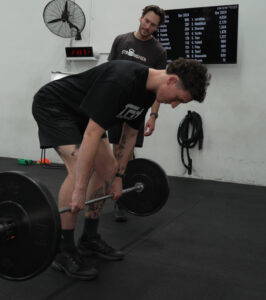Thanks a lot Covid.
If there’s one victim of the pandemic that doesn’t get nearly enough airtime, it’s your posture!
Thanks to the pandemic induced working from home era, a lot of us find ourselves hunched over a keyboard all day battling a tight neck, aching back and stiff and sore shoulders by the end of the day.
If this sounds anything like you, you might need to improve your desk ergonomics. (Ergonomics is a fancy word that basically means arranging things to make them better).
Here’s 6 of my favourite ways to improve posture when chained to a desk that your back, neck and shoulders will love;
-
Maintain a gentle sway in your lower back:
Four out of five adults experience lower back pain. To help with this, sit with your butt all the way up against the back of the seat and place a small, firm cushion in the hollow area of your lower spine where your back naturally sways. This will help maintain the natural curve of your lower back and reduce the risk of lower back pain.

You can purchase cushions like this on Amazon for $30
2. Bend your elbows 90 degrees:
Your desk should be at whatever height allows your elbows to bend at 90 degrees while typing. If your chair has adjustable arms, make sure they are at this height as well. This will help reduce shoulder and elbow strain.
3. Position your chin parallel to the ground for proper posture:
Neck pain and headaches can occur if you spend long hours staring at a screen that is too high or too low. To avoid this, position your screen directly in front of your natural eye level. This will help keep your neck in a neutral position.

4. Draw your chin back and tuck slightly:
Most of us jut our chin out slightly when we are looking at a screen, which can place stress on the cervical spine. Draw your chin back so it is right behind your collarbones. Then, tuck your chin slightly as if you are holding a tennis ball with your chin. This will help reduce neck pain.
5. Open your shoulders:
Most people slouch to some degree, but the truth is, it’s hard on your spine and back. To avoid slouching, gently roll your shoulders down and back. This will help keep your spine straight and reduce the risk of back pain.

6. Bend your knees 90 degrees, feet flat on the ground:
Good posture starts in your feet — think of them as the foundation of your posture. It is pretty much impossible to maintain a straight spine if your feet are not pressed flatly against the floor, especially for hours at a time. This will help reduce pressure on your lower back and promote good posture.
In addition to these tips, here are some useful accessories for you if you work from home:
A sit-to-stand desk: One study showed a 32 percent improvement in lower back pain when people stood intermittently through their workday.
Amazon Link
A lumbar roll: If your chair does not have low back support, it is crucial to support your lumbar spine with a cushion.
Amazon Link
Use a posture app: Posture Man Pat uses your laptop’s webcam to remind you when you are slouching. While this feature may strike some as intrusive — if not creepy — it’s completely free. The other, less creepy option is to simply set a timer for every 30 minutes to remind yourself to get up and move, and then reset to a good posture.
Stand up every hour: Even if you have trained yourself to sit with perfect posture all day long, humans were not built to sit for 8 hours at a stretch. Standing up pulls you out of your static position and gets your muscles and joints moving again.
External mouse and keyboard: If you work with a laptop, it is virtually impossible to maintain proper sitting posture without these essential accessories.
Laptop stand: Remember, your screen needs to be positioned at eye level.
Making where you work more ergonomic is the fastest way to improve your posture and reduce daily aches and pains that come from hunching over a keyboard. Remember to take frequent breaks to stand up and move, use the appropriate accessories, and position your desk equipment correctly.
By following the tips outlined above, you can promote good posture, reduce the risk of pain and discomfort, and work more comfortably and efficiently.
Remember to tune in to The Performance Hub Podcast for more tips, tricks and banter!
And be sure to view our other BLOG articles


